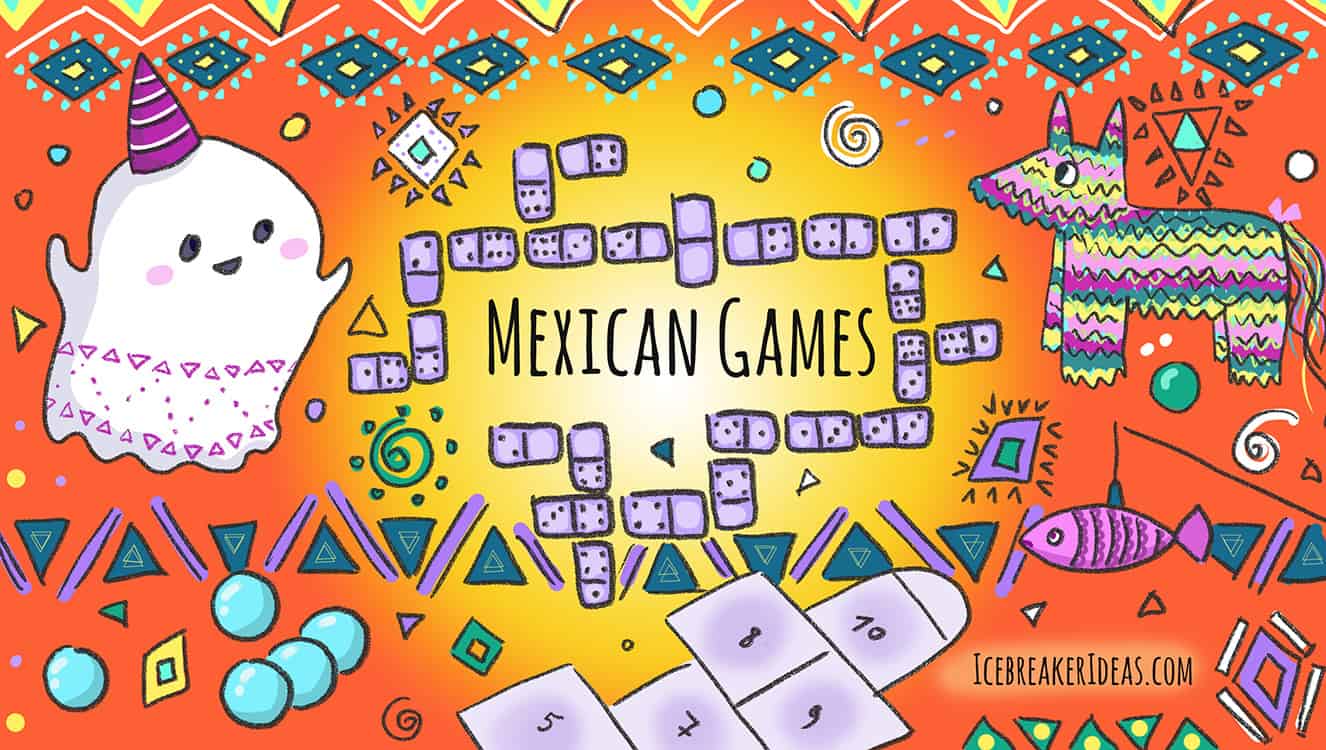Enjoying different cultures can be fun for kids and adults alike when you look at games from across the world. Some of the best Hispanic games will incorporate learning. Many Mexican party games will involve having a wholesome good time while learning about Hispanic heritage.
Table of Contents
For those familiar with the Spanish language and those completely new, you’re sure to have a great time with these Fiesta party games and Mexican activities!
Veo, Veo
This game is fantastic to start with and is especially fun for kids and adults that want to practice some language skills. The game functions very similarly to I Spy, in English. Start by saying “Veo, Veo,” and then you can describe something with a few vague concepts, like color and size.
One of the crucial differences is having the player or players answer in Spanish rather than in English. Depending on how advanced the people playing are in their vocabulary, it can be helpful to prepare this Mexican activity with a pre-set bag of toys and other objects to use.
The more you and your players know of the Spanish language, you can start speaking the entire game in Spanish to test everyone’s knowledge. With young learners, a helpful tool for visually representing new worlds is the Veo Veo song.
La Pirinola
La Pirinola is a top spinning game played using chips to represent points. La Pirinola is also called the toma todo game based on what country it is played in. This Hispanic game can be found in Argentina, Columbia, Chile, and Mexico.
The rules for La Pirinola are very similar to the Hanukkah Dreidel game, but instead of learning a bit about Hebrew letters, you can learn a little Spanish.
The six-sided top used in this game gives directions for players whenever they spin. Results vary from putting multiple chips into a central pot, taking some out of the center, forcing everyone to put chips into the center, and taking all the middle chips at once.
Once there is only one player with chips, they are declared the winner of this fiesta party game. The Spanish involved is limited to six phrases, many of which refer to similar things, so it’s a stellar game for younger audiences.
Piñata
The pinata is a classic staple of many parties. The origins of this birthday celebration centerpiece likely come from China. Regardless of where it comes from, this simple paper-mâché object is a real crowd-pleaser.
Filling a pinata with candy is sure to get kids of all ages excited towards the end of a party or get-together. Few Mexican party games are as recognizable by people as the simple and effective pinata.
If you decide to hang one up for a birthday party, it’s not uncommon to let the birthday boy or girl swing at the pinata until it breaks. Most parties make a game of hanging a pinata up and having kids take turns whacking the candy container with a blindfold on. You get one swing before passing the bat and blindfold off to the next person.
When the pinata breaks, that child can even take first dibs on some of the candy!
Domino Cubano/Mexican Train Dominoes
This game is much more suited for a group of adults that already enjoy board games and other tabletop experiences. Mexican train rules for a game of dominoes require two to four players and can incorporate any domino set.
Depending on the number of players and the set you are using, each person gets seven to fifteen dominoes. Players attempt to extend outward from the center domino to have no dominoes in their hands.
At the end of each round, players receive points based on the domino pips in their hands. By the end of a set number of rounds, the player with the fewest points is declared the winner.
The titular Mexican train is a completely public trail of dominoes that anyone can play on at any point. Most of the trains are considered private as soon as someone places a domino down, but the Mexican train remains open throughout the entire game.
Mar Y Tierra
A good game doesn’t always need special equipment to present a great time. Mexican games for kids such as Mar y Tierra require anyone playing to learn only two words of Spanish to participate.
As long as you have some kind of representation of a dividing line, you can get people together to play. It’s like a super simplified Simon Says in some ways.
One side of the line is called Mar, while the other is called Tierra. A designated caller will shout out one word or the other, and all the players will need to jump in place or over the line to the correct side. Anyone that jumps to the wrong side is out, and as soon as only one person is left, they are declared the winner.
Rarájipari
Although played originally in Mexico over miles and miles of road, canyon trail, or desert, this game can be made more appropriate for yards or fields on a smaller scale. Rarájipari is a running game centered around two groups each kicking a ball while racing one another.
It’s not uncommon for small parties to set up little obstacle courses for teams to kick a ball through, with the first team to entirely get across the finish line with the ball declared the winner.
Traditional Rarájipari usually designates a front-runner to handle the ball, but for smaller fiesta party games, it’s okay to have everyone on the team kicking the ball forward. Courses can be as short or as long as you think people will be okay running through. The classic game also uses a wooden ball, but a kickball or soccer ball would suffice.
Lotería
This Latin American equivalent of BINGO presents a challenge for those learning Spanish as well as a fun party game. While you will need to find lotería cards online or through a digital sales platform, printing them out is most of what you’ll need to play.
Any kind of token will work, just like in BINGO. Any random selection method will work for determining the next icon to call out. Thanks to each square including a picture and a word, even those that aren’t one-hundred percent confident in their Spanish can play along just fine.
Once any player gets a full line of markers, they can try and end the game. As long as the called-out squares match all of theirs, they win.
Sardina
Similar to traditional hide and seek, Sardina is a game in which only one person hides while everyone else involved tries to find them. Another twist on this classic game is that once any of the seekers find the original hider, they have to join them in that spot.
As the game continues, it becomes easier and easier to find the hidden group, as they are all in a huge group. If you want to make it more of a competition, you can rule that the last person to find the huge group of hidden people is considered the loser.
Counting down before finding the hiding person can also be done in Spanish for an additional learning moment for the larger group of people.
Chiviri Cuarta
Another variant of the classic hide and seek is this traditional game. Unlike Sardina, everyone but one person is hiding. Before the countdown begins and the seeker goes looking for people, decide on a base or object to touch during the game.
Whenever the seeker finds someone hiding, they need to run back to the base and call out a Spanish phrase along with that person’s name to catch them. Once they yell “Chiviri Cuarta Por” and then the person’s name, they’ve been caught.
At the same time, when a hider gets found, they have a chance to run back to the base and hell out a phrase to stay safe.
Each time a hider is completely caught by the seeker, they join their team and help find people during the next round. The game continues until no one is hiding from the team of seekers.
La Víbora De La Mar
This game means “the sea snake” in Spanish. Also called pasemisí, this children’s game incorporates music and motion to entertain kids similar to Ring Around the Rosie or other song-based activities.
The game begins with two children forming an arch with their hands, each designated as a different fruit, either cantaloupe or watermelon. All the other kids form a line and pass through the arch while everyone sings.
The “snake” gets to keep moving through the arch, but at the end of each tiny verse, the two kids can decide to bring their arms down and capture one of the kids in the snake. After getting captured, the kid will pick a side and make another arch.
Once every part of the snake is captured by the two fruits, the sides compete in a game of tug- of war, and then a side is declared the winner. This game requires a bit more knowledge of Spanish, or the song’s English translation, but allows for music, fun, and competition all at once.
El Repollo
Similar to hot potato mixed with truth or dare, this game incorporates a little bit of Spanish and some nice festive energy.
To set the game up, have each of the players write down a question, ideally in Spanish for the sake of learning a little, on pieces of paper. Wad all of the paper up and tape it if you need to form a ball that can be thrown from person to person.
Put on some music or have people sing a song as the ball is tossed back and forth. Have someone in charge stop the singing or press pause on the music. Whoever has the ball when the music stops must take a piece of paper from the ball and answer the question written down.
This game allows people of all ages and understandings to practice a bit of Spanish and have fun with a big group of friends.
1, 2, 3, Calabaza
Although played as “Red Light, Green Light,” in English, 1, 2, 3, Calabaza is one of the most classic Mexican games for kids. Like many other basic party games, it only requires some space to play in, and knowledge of four Spanish words.
The leader faces a wall and counts up in Spanish. Everyone else tries to move closer and closer to the leader while their back is turned. Once they count to three, they can shout out, and spin around.
Anyone caught moving has to return to the starting line. The game concludes when someone makes it to where the leader is and can take their place so everyone gets a chance to win.
Dancing to Music
Plenty of traditional dances exist in Hispanic culture, but we recommend trying to learn the jarabe, a folk dance designed for couples throughout Mexico. Much like Mexican games for adults, trying to learn this dance can be an enriching and active experience. Depending on where you look, you can find variations of this dance that involve going around a sombrero.
Putting on classic Mexican music can also make a fun time for parties with large groups of people. Even if you aren’t a big fan of new genres, plenty of people could discover something to enjoy by branching out of their comfort zones.
Conclusion
That’s thirteen of the best possible games played in Hispanic cultures. These Mexican party games are appropriate for people looking to learn and those wanting to have fun in a group. Friends and family alike can get behind these festive activities.
Make sure to try out some of these Mexican games for kids and Mexican games for adults when you’re planning your next big get-together. For people of all skill levels in the Spanish language, you can have a fun time and learn a little all at once.




